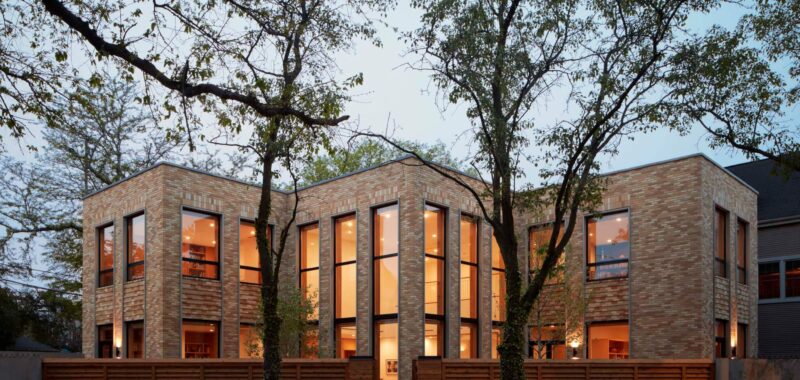In a residential neighborhood, the corner lot is usually the most coveted. This one needed a visionary owner—and architect—to reach its full potential. Located in Chicago’s picturesque Lincoln Park area, the 5,040-square-foot plot seemed the perfect fit for an empty-nester couple looking for a home to support their work, interests, and new life stage. It has easy access to the north branch of the Chicago River and is close to a local pocket park, but the existing home was a dilapidated 1960s Spanish-style bungalow that needed a total rehaul. Another catch? The site is oddly triangular. All of this encouraged the clients to go with a custom build to replace it.
“We’ve done a lot of city houses over the years, and this site’s shape was very unusual,” said architect Larry Booth, founder of Chicago firm Booth Hansen. With lot lines on the north and west sides that form a right angle connected by a 150-foot-long hypotenuse along the street, only truly creative architecture could meet his clients’ goals: an all-electric home with ample daylighting and extensive outdoor space. Booth Hansen embraced the challenge and went beyond it, creating a statement house uniquely tailored to the couple’s lifestyle that also achieves nearly net-zero energy performance.


Like any building project concerned with sustainability, it had to start with reuse. Booth Hansen’s design for the new 2-story, 4,336-square-foot home incorporates two walls, part of the foundation, and a 6-foot-tall stucco perimeter fence from the former midcentury bungalow. Along the hypotenuse side of the site there’s now a stepped, tumbled brick facade set back from the fenced lot line. Here, Illinois-based Mariani Landscape created a meandering green space with zones for gardening, barbecuing, and gathering outdoors. In the owners’ prior residence, which had small windows and suffered from a lack of sunlight, “they felt very claustrophobic,” Booth told AN. Now, large front windows, some as tall as 22 feet, are oriented to maximize daylighting from the south and east while creating a seamless visual connection between the garden and the airy interior—a double-height living room and kitchen, two bedrooms, his-and-hers offices, and a well-loved den.

“What’s interesting is [this design] allowed us to get a lot of privacy from the outside but an enormous openness from the inside, so you don’t feel exposed in the house at all,” explained Booth, who worked with colleague Kelly Tang on the design. One hardly notices the pair of mostly uninterrupted masonry walls at the back, which keep the house’s overall percentage of glass low. In tandem with other sustainable design features, including continuous insulation, an air-source heat pump and energy recovery ventilator, all electric appliances, and a roof covered in solar panels, the home’s Energy Use Intensity is 3. (A typical Chicago house would score around 49.5, said Tang.) Though reaching a net-zero design was physically possible, the couple decided to prioritize some cost-saving measures and larger front windows—a decision that exposes the exclusive nature of some of today’s most advanced sustainability specs.

Booth and Tang chose white oak, porcelain, and stone interior finishes for the house to curate a natural, neutral palette. Local designer Deanna Berman decorated its rooms with custom, contemporary, and midcentury furnishings in a similarly inspired color scheme. “We don’t think form follows function nor that function follows form,” said Booth. “The two have to be integrated and made harmonious.”
Elizabeth Fazzare is a New York–based editor and journalist who covers architecture, design, culture, and travel.

